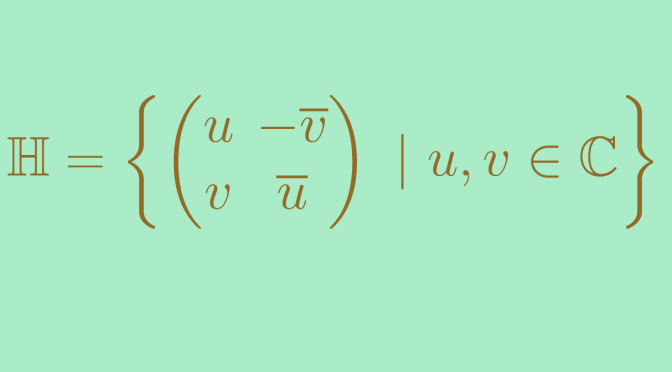We give here an example of a division ring which is not commutative. According to Wedderburn theorem every finite division ring is commutative. So we must turn to infinite division rings to find a non-commutative one, i.e. a skew field.
Let’s introduce the skew field of the Hamilton’s quaternions \[\mathbb H = \left\{\begin{pmatrix}
u & -\overline{v} \\
v & \overline{u}
\end{pmatrix} \ | \ u,v \in \mathbb C\right\}\]
\(\mathbb H\) is a subring of \(\mathcal M_2(\mathbb C)\) (the set of matrices of dimension \(2\) over \(\mathbb C\))
One can easily verify that the identity matrix is an element of \(\mathbb H\) taking \((u,v)=(1,0)\). Also the sum and the product of two elements of \(\mathbb H\) belong to \(\mathbb H\).
The non-zero elements of \(\mathbb H\) are invertible
Take \((0,0) \neq (u,v) \in \mathbb C^2\). The determinant of \(A=\begin{pmatrix}
u & -\overline{v} \\
v & \overline{u}
\end{pmatrix}\) is \(\delta=\det A = \vert u \vert^2 + \vert v \vert^2 >0\). Hence \(A\) is invertible and \[A^{-1}=\frac{1}{\delta}\begin{pmatrix}
\overline{u} & \overline{v} \\
-v & u
\end{pmatrix}\]
Hence \(\mathbb H\) is a division ring.
\(\mathbb H\) is not commutative
We denote \(\textbf{id}=\begin{pmatrix}
1 & 0 \\
0 & 1
\end{pmatrix}\),
\(i=\begin{pmatrix}
i & 0 \\
0 & -i
\end{pmatrix}\), \(j=\begin{pmatrix}
0 & 1 \\
-1 & 0
\end{pmatrix}\) and \(k=\begin{pmatrix}
0 & i \\
i & 0
\end{pmatrix}\). All are elements of \(\mathbb H\). The identities hold \[i^2=j^2=k^2=ijk=-1\] as well as following ones
\[ij=-ji=k\] \[jk=-kj=i\] \[ki=-ik=j\]
proving that \(\mathbb H\) is not commutative. \(\mathbb H\) is a skew field.
\(\mathbb H\) is a vector space of dimension \(4\) over \(\mathbb R\)
One can verify that any matrix \(P=\begin{pmatrix}
a+bi & c+di \\
-c+di & a-bi
\end{pmatrix}\) of \(\mathbb H\) (with \(a,b,c,d \in \mathbb R^4\)) can be written \[P=a \textbf{id} + bi +cj +dk\] As \((\textbf{id}, i, j, k)\) is an independent family, it is a basis of \(\mathbb H\). Hence the result. One can also verify that \(\mathbb R \textbf{id}\) is included in \(\mathbb H\) center.

